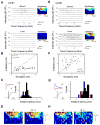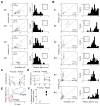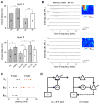Preceding inhibition silences layer 6 neurons in auditory cortex
- PMID: 20223205
- PMCID: PMC2904750
- DOI: 10.1016/j.neuron.2010.02.021
Preceding inhibition silences layer 6 neurons in auditory cortex
Abstract
A canonical feedforward circuit is proposed to underlie sensory cortical responses with balanced excitation and inhibition in layer 4 (L4). However, in another input layer, L6, sensory responses and the underlying synaptic circuits remain largely unclear. Here, cell-attached recordings in rat primary auditory cortex revealed that for the majority of L6 excitatory neurons, tonal stimuli did not drive spike responses, but suppressed spontaneous firings. Whole-cell recordings further revealed that the silencing resulted from tone-evoked strong inhibition arriving earlier than excitation. This pattern of inputs can be attributed to a parallel feedforward circuit with both excitatory and inhibitory inputs disynaptically relayed. In contrast, in the other neurons directly driven by thalamic input, stimuli evoked excitation preceding relatively weak inhibition, resulting in robust spike responses. Thus, the dichotomy of L6 response properties arises from two distinct patterns of excitatory-inhibitory interplay. The parallel circuit module generating preceding inhibition may provide a gating mechanism for conditional corticothalamic feedback.
Copyright 2010 Elsevier Inc. All rights reserved.
Figures






Similar articles
-
Defining cortical frequency tuning with recurrent excitatory circuitry.Nat Neurosci. 2007 Dec;10(12):1594-600. doi: 10.1038/nn2012. Epub 2007 Nov 11. Nat Neurosci. 2007. PMID: 17994013 Free PMC article.
-
Synaptic and cellular properties of the feedforward inhibitory circuit within the input layer of the cerebellar cortex.J Neurosci. 2008 Sep 3;28(36):8955-67. doi: 10.1523/JNEUROSCI.5469-07.2008. J Neurosci. 2008. PMID: 18768689 Free PMC article.
-
Synaptic mechanisms underlying functional dichotomy between intrinsic-bursting and regular-spiking neurons in auditory cortical layer 5.J Neurosci. 2013 Mar 20;33(12):5326-39. doi: 10.1523/JNEUROSCI.4810-12.2013. J Neurosci. 2013. PMID: 23516297 Free PMC article.
-
How do neurons work together? Lessons from auditory cortex.Hear Res. 2011 Jan;271(1-2):37-53. doi: 10.1016/j.heares.2010.06.006. Epub 2010 Jul 11. Hear Res. 2011. PMID: 20603208 Free PMC article. Review.
-
How inhibition shapes cortical activity.Neuron. 2011 Oct 20;72(2):231-43. doi: 10.1016/j.neuron.2011.09.027. Neuron. 2011. PMID: 22017986 Free PMC article. Review.
Cited by
-
Generation of intensity selectivity by differential synaptic tuning: fast-saturating excitation but slow-saturating inhibition.J Neurosci. 2012 Dec 12;32(50):18068-78. doi: 10.1523/JNEUROSCI.3647-12.2012. J Neurosci. 2012. PMID: 23238722 Free PMC article.
-
Intracortical multiplication of thalamocortical signals in mouse auditory cortex.Nat Neurosci. 2013 Sep;16(9):1179-81. doi: 10.1038/nn.3493. Epub 2013 Aug 11. Nat Neurosci. 2013. PMID: 23933752 Free PMC article.
-
GABAergic synapses: their plasticity and role in sensory cortex.Front Cell Neurosci. 2014 Mar 26;8:91. doi: 10.3389/fncel.2014.00091. eCollection 2014. Front Cell Neurosci. 2014. PMID: 24723851 Free PMC article. Review.
-
Diversity in Excitation-Inhibition Mismatch Underlies Local Functional Heterogeneity in the Rat Auditory Cortex.Cell Rep. 2017 Apr 18;19(3):521-531. doi: 10.1016/j.celrep.2017.03.061. Cell Rep. 2017. PMID: 28423316 Free PMC article.
-
Theory of optimal balance predicts and explains the amplitude and decay time of synaptic inhibition.Nat Commun. 2017 Mar 10;8:14566. doi: 10.1038/ncomms14566. Nat Commun. 2017. PMID: 28281523 Free PMC article.
References
-
- Anderson JS, Carandini M, Ferster D. Orientation tuning of input conductance, excitation, and inhibition in cat primary visual cortex. J Neurophysiol. 2000;84:909–926. - PubMed
-
- Borg-Graham LJ, Monier C, Frégnac Y. Visual input evokes transient and strong shunting inhibition in visual cortical neurons. Nature. 1998;393:369–373. - PubMed
-
- Crick F, Koch C. Constraints on cortical and thalamic projections: the no-strong-loops hypothesis. Nature. 1998;391:245–250. - PubMed
Publication types
MeSH terms
Substances
Grants and funding
LinkOut - more resources
Full Text Sources

